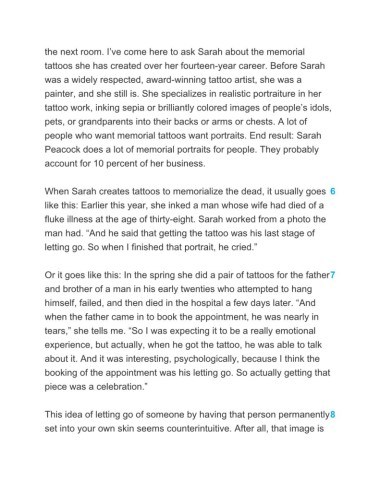Page 1108 - Wordsmith A Guide to College Writing
P. 1108
the next room. I’ve come here to ask Sarah about the memorial
tattoos she has created over her fourteen-year career. Before Sarah
was a widely respected, award-winning tattoo artist, she was a
painter, and she still is. She specializes in realistic portraiture in her
tattoo work, inking sepia or brilliantly colored images of people’s idols,
pets, or grandparents into their backs or arms or chests. A lot of
people who want memorial tattoos want portraits. End result: Sarah
Peacock does a lot of memorial portraits for people. They probably
account for 10 percent of her business.
When Sarah creates tattoos to memorialize the dead, it usually goes 6
like this: Earlier this year, she inked a man whose wife had died of a
fluke illness at the age of thirty-eight. Sarah worked from a photo the
man had. “And he said that getting the tattoo was his last stage of
letting go. So when I finished that portrait, he cried.”
Or it goes like this: In the spring she did a pair of tattoos for the father 7
and brother of a man in his early twenties who attempted to hang
himself, failed, and then died in the hospital a few days later. “And
when the father came in to book the appointment, he was nearly in
tears,” she tells me. “So I was expecting it to be a really emotional
experience, but actually, when he got the tattoo, he was able to talk
about it. And it was interesting, psychologically, because I think the
booking of the appointment was his letting go. So actually getting that
piece was a celebration.”
This idea of letting go of someone by having that person permanently 8
set into your own skin seems counterintuitive. After all, that image is

